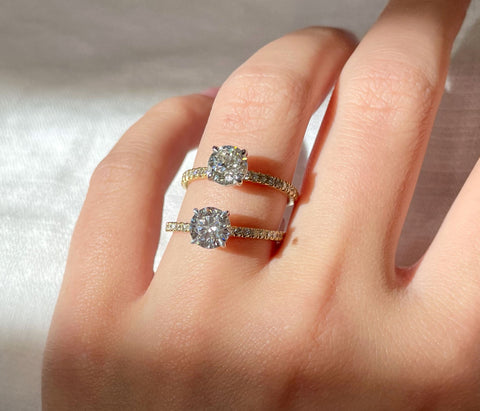Lab Grown vs Mined Diamonds
Lab grown diamonds are increasing in popularity, with more brides-to-be considering these diamonds as an alternative to traditional mined diamonds. At Class A we are pleased to offer both lab grown and mined diamonds! Many are still sceptical about lab grown diamonds as they are a relatively new and unknown territory. It is important to emphasise that lab grown diamonds are diamonds and not diamond simulants and should not be compared to other gemstones such as Cubic Zirconia or Moissanite. Interested in learning more about the difference between lab grown and mined diamonds? The ultimate guide awaits...
CREATION
Mined diamonds are created by nature. Billions of years of intense heat and pressure creates these precious stones. So, how could a lab possibly recreate this? These precious stones are created in less of a ‘lab’ and more of a high-tech factory. They are created through one of two methods: ‘high pressure, high temperature’ or ‘chemical vapour deposition’. ‘High pressure, high temperature’ uses extreme temperature and pressure, as in its name, to mimic the environment that diamonds are naturally created in. Contrastingly, ‘chemical vapour deposition’ is like 3D printing and creates diamonds by feeding energised gasses into a vacuum chamber, like a microwave. Both methods use a ‘seed’ or a tiny sliver of another diamond to start the creation process. A diamond will be formed in just a few weeks! Due to this creation process, factors that would normally affect mined diamonds can be controlled, leading to more high-quality diamonds being produced.
There is only a slight chemical difference between lab grown and mined diamonds. Mined diamonds often contain a tiny amount of nitrogen, whilst lab grown diamonds are purely carbon. This difference does not mean that lab grown diamonds are not real diamonds. Lab diamonds are just as strong and hard as mined diamonds, with both stones scoring a 10 on the Mohs scale of hardness. For jewellers and gemmologists, it’s almost impossible to tell the difference between a mined and a lab-created diamond with the naked eye. However, with specialised equipment, a gemmologist may be able to identify a lab-created diamond.
PRICE
Lab grown diamonds are significantly more affordable than their mined counterparts. Mined diamond supply is limited, as all the world’s mined diamonds have already been formed over billions of years. This limited supply increases the value of mined diamonds. However, with lab grown diamonds, there is no limit on supply which drives the price lower.
Although once perceived as ‘less authentic and valuable’ when compared to their mined counterparts, lab grown diamonds are now viewed as a more sustainable and ‘guilt-free’ option with price playing an important factor for many couples, as they can access bigger diamonds at lower prices.
The difference between a lab grown and mined diamond can be hard to imagine, so we have provided some examples for comparison. Pictured below are two of our JESSICA engagement rings, they both feature 1 carat centre diamonds, with a F colour and SI1 clarity grading, and are set in 18ct white gold. The mined diamond is pictured on the top with the lab grown at the bottom. The mined diamond ring is $23,990, whilst the lab grown diamond ring is $6,849.

Another example is our EMILIE design. Both rings feature 1ct centre diamonds, with an F colour and SI1 clarity grading, set in 18ct yellow gold. The top ring features a mined diamond and is $24,899. The bottom ring is the lab grown diamond and is $7,549.

For many couples, price is an important factor in determining their engagement ring. Choosing a lab grown diamond provides couples with the opportunity to purchase the larger diamond they have always dreamed of!
SUSTAINABILITY
Sustainability is another factor many clients consider when selecting between a laboratory grown or mined diamond. Many believe that lab grown diamonds are better for the environment, as the earth is not damaged by the traditional mining methods required for a mined diamond. Lab grown diamond factories also have less land and water requirements than diamond mines and many of these factories are powered with renewable energy. However, the factories do consume a large amount of energy due to the intense heat required to create laboratory grown diamonds. Although not as sustainable for our planet, the diamond mining process creates jobs, particularly in countries where diamond mining is their main source of income such as Sierra Leone. According to the De Beers Group, the mined diamond industry generates $16 billion in socioeconomic benefits for countries whose economies rely on the diamond industry, with 60% of these profits retained in their local economy. With the introduction of The Kimberley Process in 2003, there are traceable and transparent methods of discovering origins for diamonds worldwide to reduce the possibility of purchasing ‘blood diamonds’.
Ultimately, sustainability can have a different meaning depending on how you interpret it. For those looking to be kinder to the planet, a lab grown diamond may be a better option. However, for those looking to support industries in other countries, through the sourcing of ethical diamonds, mined diamonds may be their preferred option.
CONCLUSION
At the end of the day, selecting the perfect stone has more to it than price and resale value, it is about the connection you have to the stone and what it represents! Some people will prefer to have a mined diamond whereas others may be more attracted to lab grown diamonds. Both are beautiful choices that will hold their meaning as heirlooms for generations to come.
Visit our showroom at 40 North East Road, Walkerville to view our wonderful collection of Lab Grown Diamond engagement rings and jewellery!
